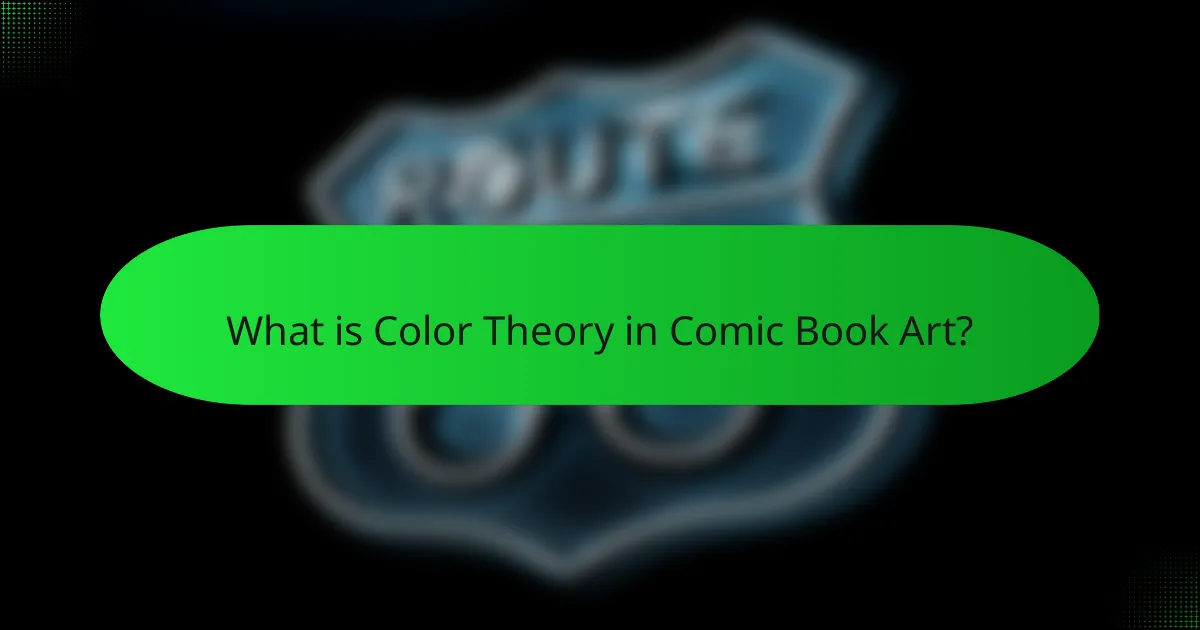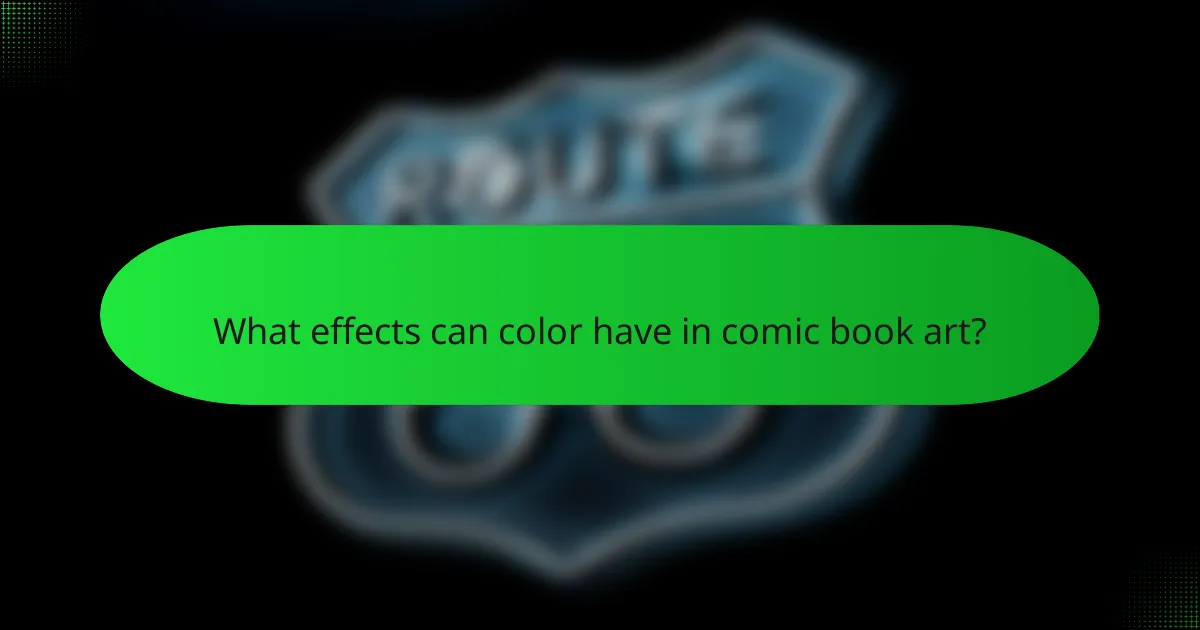Color theory in comic book art encompasses the principles that guide the use of color to communicate meaning and emotion within visual narratives. This article explores the fundamental concepts of color theory, including the color wheel, color harmony, and the contextual relationships between colors, which are crucial for effective storytelling. It highlights how comic book artists utilize color to evoke specific emotions, establish mood, and direct reader attention. Techniques such as color blocking, layering, and blending are discussed, along with the psychological effects of color combinations on audience perception. Through these insights, the article demonstrates the significant role of color in enhancing narrative and visual appeal in comic books.

What is Color Theory in Comic Book Art?
Color theory in comic book art refers to the principles governing the use of color to convey meaning and emotion. It involves understanding how colors interact, influence perception, and affect storytelling. Comic book artists employ color theory to create mood, establish focus, and enhance narrative elements. For instance, warm colors like red and yellow can evoke excitement or urgency. In contrast, cool colors such as blue and green often suggest calmness or sadness. The application of color theory helps artists guide readers’ emotional responses and improve visual storytelling. Studies in color psychology support these associations, demonstrating how color impacts human emotions and perceptions.
How does color theory influence comic book storytelling?
Color theory significantly influences comic book storytelling by using colors to convey emotions and set the mood. Different colors evoke specific feelings; for example, red can signify danger or passion, while blue often represents calmness or sadness. Artists strategically choose color palettes to enhance narrative elements. This technique helps to guide the reader’s emotional response to scenes.
Studies show that color choices can affect reader interpretation of character motivations. For instance, a character surrounded by warm colors may appear more inviting or heroic. Conversely, cold colors can make a character seem distant or villainous. Comic creators often use color contrasts to highlight key moments or actions, drawing attention to important plot points.
The use of color gradients can also convey time of day or the passage of time, enriching the storytelling experience. Overall, color theory serves as a vital tool in shaping the visual language of comic books, enhancing both storytelling and emotional engagement.
What are the key components of color theory relevant to comic book art?
The key components of color theory relevant to comic book art include the color wheel, color harmony, and color psychology. The color wheel organizes primary, secondary, and tertiary colors. Primary colors are red, blue, and yellow. Secondary colors are green, orange, and purple, created by mixing primary colors. Tertiary colors result from mixing primary and secondary colors.
Color harmony refers to aesthetically pleasing combinations of colors. Complementary colors, which are opposite each other on the color wheel, create high contrast and visual interest. Analogous colors, located next to each other on the wheel, produce a more harmonious and serene effect.
Color psychology examines how colors influence emotions and perceptions. For example, red can evoke excitement or danger, while blue often conveys calmness or sadness. Understanding these components helps artists convey mood and narrative effectively in comic book art.
How do color choices affect character perception in comics?
Color choices significantly influence character perception in comics. Different colors evoke distinct emotions and associations. For instance, red often symbolizes passion or aggression, while blue can represent calmness or sadness. These color associations impact how readers interpret characters’ personalities and intentions. A character dressed in dark colors may be perceived as villainous or mysterious. Conversely, bright colors typically suggest heroism or friendliness. Studies indicate that color can alter a viewer’s emotional response and engagement with the narrative. Thus, effective color usage is essential for conveying character traits and enhancing storytelling in comic art.
Why is understanding color theory important for comic artists?
Understanding color theory is crucial for comic artists because it enhances storytelling and visual impact. Color theory provides a framework for selecting colors that evoke emotions and set the mood. For instance, warm colors can create feelings of excitement or aggression, while cool colors often convey calmness or sadness.
Effective use of color can guide the viewer’s eye and emphasize key elements in a panel. Artists can use contrasting colors to highlight important characters or actions. Additionally, color harmonies can create a cohesive look throughout the comic.
Research shows that color choices significantly affect reader engagement and comprehension. A study published in the Journal of Visual Literacy indicates that color can influence perceptions of narrative tension and character relationships. Thus, mastering color theory enables comic artists to create more compelling and effective visual narratives.
How can color theory enhance visual impact in comic illustrations?
Color theory enhances visual impact in comic illustrations by guiding the use of color to evoke emotions and create focus. It helps artists choose color schemes that complement the narrative and characters. For example, warm colors can convey excitement or danger, while cool colors often suggest calmness or sadness. The contrast between colors can draw attention to key elements, making them stand out. Studies show that specific color combinations can influence viewer perception and engagement. The principles of color harmony and balance can lead to more aesthetically pleasing compositions. Additionally, color can indicate time, setting, and mood, enriching the storytelling experience.
What role does color play in creating mood and atmosphere in comics?
Color plays a crucial role in creating mood and atmosphere in comics. It enhances emotional responses and sets the tone of the narrative. Different colors evoke specific feelings; for instance, blue can convey sadness, while red often signifies passion or danger. Artists use color palettes to reflect character emotions and story dynamics. Warm colors typically create an inviting atmosphere, while cool colors can evoke tension or isolation. Historical comics, like “Maus” by Art Spiegelman, utilize color strategically to emphasize themes and emotions. This intentional use of color influences reader perception and engagement with the story.

What are the fundamental principles of color theory?
The fundamental principles of color theory include the color wheel, color harmony, and the context of colors. The color wheel organizes colors based on their relationships. Primary colors are red, blue, and yellow. Secondary colors are created by mixing primary colors. Tertiary colors result from mixing primary and secondary colors. Color harmony involves aesthetically pleasing combinations of colors. Common harmonies include complementary, analogous, and triadic schemes. The context of colors refers to how colors interact with each other and their surroundings. This principle affects perception and emotional responses to color. Understanding these principles is essential for effective color application in art and design.
What are the primary colors and their significance in comic art?
The primary colors in comic art are red, blue, and yellow. These colors serve as the foundation for creating a wide range of hues through mixing. In comic art, primary colors are significant for their emotional and symbolic meanings. Red often conveys excitement, passion, or danger. Blue typically represents calmness, sadness, or trust. Yellow is associated with happiness, optimism, and energy.
Comic artists strategically use these colors to evoke specific feelings and reactions from the audience. For instance, a scene filled with red may heighten tension or urgency. Conversely, a predominance of blue can create a serene or melancholic atmosphere. Yellow can draw attention to key elements, enhancing visual impact.
The significance of primary colors in comic art lies in their ability to influence narrative tone and character perception. Understanding color theory allows artists to effectively communicate themes and emotions through visual storytelling.
How do secondary and tertiary colors expand the color palette?
Secondary and tertiary colors expand the color palette by providing additional hues that enhance creative options. Secondary colors, formed by mixing primary colors, include green, orange, and purple. These colors introduce new visual dynamics and contrast. Tertiary colors, created by mixing a primary color with a secondary color, offer even more variety. Examples of tertiary colors include red-orange and blue-green. Together, these colors allow for more nuanced color schemes. They enable artists to convey emotions and themes effectively. The expanded palette supports greater depth and interest in comic book art.
What is the color wheel and how is it used in comic book art?
The color wheel is a visual representation of colors arranged according to their chromatic relationship. It helps artists understand color relationships, such as complementary and analogous colors. In comic book art, the color wheel is used to create mood and depth. Artists select colors based on their position on the wheel to evoke emotions. For example, warm colors can create excitement, while cool colors can convey calmness. Additionally, the color wheel assists in maintaining color harmony throughout the artwork. By applying these principles, comic book artists enhance storytelling through visual impact.
What are the concepts of color harmony and contrast?
Color harmony refers to the pleasing arrangement of colors that create a sense of balance and aesthetic appeal. It involves using colors that complement each other, often derived from color theory principles such as analogous, complementary, and triadic color schemes. Contrast, on the other hand, is the difference between colors that makes them stand out against each other. High contrast can draw attention and create visual interest, while low contrast offers a more subdued effect. Both concepts are essential in comic book art, as they influence mood, focus, and readability. Effective use of color harmony and contrast can enhance storytelling and guide the viewer’s eye through the artwork.
How do complementary colors create visual tension in comics?
Complementary colors create visual tension in comics by contrasting hues that are opposite each other on the color wheel. This contrast draws attention and enhances the visual impact of the artwork. For example, the use of red and green can highlight important elements in a panel. This technique can evoke emotions and create a dynamic atmosphere. Studies show that high contrast can influence viewer perception and engagement. Artists strategically use complementary colors to guide the reader’s eye and emphasize narrative elements. The tension created can enhance storytelling by making scenes more dramatic.
What are analogous colors and when should they be used?
Analogous colors are colors that are next to each other on the color wheel. They typically consist of three colors, including one dominant hue and two supporting hues. These colors create a harmonious and visually appealing palette. Artists often use analogous colors to convey a specific mood or atmosphere. For example, a combination of blue, blue-green, and green can evoke calmness. In comic book art, analogous colors enhance depth and dimension. They are effective for creating transitions and gradients. Using analogous colors can unify a composition and guide the viewer’s eye.

What effects can color have in comic book art?
Color in comic book art can significantly impact storytelling and emotional engagement. It enhances mood and atmosphere through the use of warm or cool tones. For example, warm colors like red can evoke excitement or anger, while cool colors like blue can create calmness or sadness. Color can also guide the reader’s eye, directing attention to key elements in a panel. High contrast colors can emphasize action or important scenes. Additionally, color schemes can establish a character’s personality or thematic elements. For instance, a character associated with vibrant colors may represent energy and positivity. Historical context shows that comics like “Spider-Man” used color to reflect the character’s emotional journey. Overall, color serves as a vital tool in conveying narrative and enhancing visual appeal in comic book art.
How does color affect character development and reader engagement?
Color significantly influences character development and reader engagement in comic book art. Colors can convey emotions and traits associated with characters. For example, red often symbolizes passion or aggression, while blue represents calmness or sadness. This emotional association helps readers quickly understand a character’s personality.
Moreover, color choices can enhance narrative themes. A character dressed in dark colors may suggest mystery or villainy. In contrast, bright colors can indicate heroism or optimism. This visual cue aids in character recognition and relatability.
Research shows that color affects readers’ emotional responses. A study by Kosslyn et al. (2001) indicates that color can enhance memory retention and emotional engagement. Therefore, effective use of color can deepen readers’ connections to characters and the story.
What emotional responses can different colors evoke in readers?
Different colors can evoke specific emotional responses in readers. Red often signifies passion or anger. Blue is associated with calmness and tranquility. Yellow typically represents happiness and optimism. Green is linked to nature and growth, fostering feelings of balance. Purple can evoke feelings of luxury or mystery. Orange often conveys enthusiasm and creativity. Each color’s emotional impact can influence the reader’s experience and interpretation of the narrative. Research in color psychology supports these associations, highlighting the psychological effects colors have on human emotions.
How can color be used to signify character traits or transformations?
Color can signify character traits or transformations by conveying emotions and psychological states. For example, red often represents passion or aggression, while blue signifies calmness or sadness. In comic book art, artists use these associations to enhance storytelling. A character’s shift from blue to red can indicate a transformation from sadness to anger. This technique is supported by color psychology research, which shows that colors evoke specific emotional responses. Additionally, color contrasts can highlight a character’s internal conflict, making their transformation more impactful. Through strategic color choices, artists effectively communicate character evolution and depth.
What are the visual effects of color in action sequences?
Color in action sequences creates emotional responses and enhances visual storytelling. Bright colors, like red and yellow, evoke excitement and urgency. Darker colors, such as blue and black, can convey tension or danger. High contrast between colors increases visual impact and draws attention to key elements. Color saturation can affect the perceived speed of movement; vibrant colors appear more dynamic. Studies show that color influences viewer perception and engagement, making scenes more memorable. For example, in films, action sequences often use a warm color palette to amplify adrenaline. This strategic use of color shapes audience reactions and enhances the narrative experience.
How does color influence the pacing and movement in comic panels?
Color significantly influences the pacing and movement in comic panels. Warm colors, such as red and orange, create a sense of urgency and speed. They draw the reader’s eye quickly across the page. Cool colors, like blue and green, tend to slow down the reading experience. They evoke calmness and can create a sense of stillness.
The arrangement of colors also affects visual flow. High-contrast colors can create dynamic movement, guiding the reader’s gaze from one panel to another. Conversely, similar colors can create a more cohesive and slower pacing. The use of color gradients can indicate transitions in time or mood, further influencing the pacing.
Studies in visual perception show that color can affect emotional responses. For example, a panel with bright colors may elicit excitement, while muted colors can evoke introspection. This emotional impact can change how quickly a reader engages with the story. Therefore, artists strategically use color to manipulate both pacing and movement in comic storytelling.
What techniques can be used to enhance action through color choices?
Techniques to enhance action through color choices include using high-contrast colors, warm colors, and dynamic color palettes. High-contrast colors create visual tension and draw attention to key elements. Warm colors like red and orange evoke energy and urgency, making scenes feel more dynamic. Dynamic color palettes can include complementary colors that clash and create excitement. Additionally, using gradients can suggest movement and depth, enhancing the sense of action. Research shows that color affects emotional responses, influencing viewers’ perception of intensity in scenes.

What application techniques should comic artists use for color theory?
Comic artists should use techniques such as color blocking, layering, and blending to apply color theory effectively. Color blocking involves using solid colors to create distinct areas in a composition. Layering allows artists to build depth by applying multiple color layers, enhancing visual interest. Blending techniques help in creating smooth transitions between colors, which can evoke emotions and set the tone.
Additionally, artists can utilize complementary colors to create contrast and draw attention to specific elements. Analogous colors can establish harmony and cohesion within a scene. The use of color temperature, such as warm and cool colors, can influence the mood and perception of space.
These techniques are supported by principles of color theory, which emphasize the psychological effects of color combinations. For instance, studies show that colors can evoke specific emotions, influencing how a comic is received by its audience.
How can artists effectively choose a color palette for their comics?
Artists can effectively choose a color palette for their comics by understanding color theory principles. They should start by defining the mood and theme of their comic. This helps in selecting colors that evoke the intended emotions. For instance, warm colors can convey excitement, while cool colors can evoke calmness.
Next, artists can create a color wheel or use existing palettes for inspiration. This visual tool assists in identifying complementary and analogous colors. Using a limited color palette can also enhance visual cohesion.
Additionally, artists should consider the characters and settings. Colors can differentiate characters and signify their traits. For example, a villain might be represented with darker tones.
Testing colors through small sketches can help visualize their impact. This iterative process allows for adjustments before finalizing the palette.
Finally, seeking feedback from peers can provide fresh perspectives. Collaboration can lead to discovering effective color combinations that resonate with audiences.
What tools and software can assist in color selection?
Color selection can be assisted by various tools and software. Adobe Color is a popular web-based tool that helps create color palettes. It allows users to explore color harmonies and trends. Coolors is another tool that generates color schemes quickly. Users can lock in colors and generate matching palettes. Paletton offers interactive color wheel functionality for designing palettes. Color Hunt provides curated color palettes for inspiration. Additionally, software like Procreate and Adobe Illustrator includes built-in color selection tools. These tools enhance the color selection process for artists and designers.
How can color layering techniques improve artwork depth?
Color layering techniques enhance artwork depth by creating visual complexity and dimension. They allow artists to build up multiple transparent layers of color. This method adds richness to the artwork. Each layer interacts with the others, producing varied hues and tones. The result is a more dynamic and engaging visual experience. Studies in art theory indicate that depth perception can be significantly improved through such techniques. Artists often use layering to simulate light and shadow effectively. This practice can make flat images appear three-dimensional. Ultimately, color layering is a foundational technique in creating immersive artwork.
What are some common challenges in applying color theory to comic art?
Common challenges in applying color theory to comic art include achieving color harmony and balance. Artists often struggle with selecting colors that complement each other while maintaining visual interest. Understanding color relationships, such as complementary and analogous colors, can be complex. Additionally, the emotional impact of colors must align with the narrative tone. Limited color palettes can restrict creativity, making it difficult to convey depth and dimension. Furthermore, translating color theory into digital formats may lead to discrepancies due to screen variations. Lastly, time constraints can hinder thorough experimentation with color choices, impacting the overall quality of the artwork.
How can artists overcome color blindness issues in their work?
Artists can overcome color blindness issues by using high-contrast colors and patterns. This approach enhances visibility for all viewers, including those with color blindness. Artists can also utilize color-blindness simulators to test their work. These tools help identify color combinations that may be problematic. Additionally, incorporating textures and shapes can convey information without relying solely on color. Research indicates that around 8% of men and 0.5% of women experience color blindness, emphasizing the need for inclusive design. By implementing these strategies, artists can create more accessible artwork.
What are the best practices for maintaining color consistency?
Use a standardized color palette to maintain color consistency. This ensures uniformity across all illustrations. Implement color swatches and reference guides during the artistic process. Consistent lighting conditions during artwork creation help achieve similar tones. Utilize color management software to calibrate displays and printers. Regularly check printed samples against digital versions for accuracy. Document color choices for future reference to maintain continuity. Collaborate with colorists to ensure a cohesive visual style throughout the comic.
What practical tips can help artists apply color theory effectively?
Artists can apply color theory effectively by understanding the color wheel. The color wheel illustrates primary, secondary, and tertiary colors. Artists should use complementary colors to create contrast. This contrast can enhance the visual impact of their work. Additionally, artists should explore analogous colors for harmony. This creates a cohesive color palette. Using warm and cool colors can evoke different emotions. Warm colors tend to energize, while cool colors can calm. Finally, artists should practice color mixing to achieve desired shades. This skill allows for greater control over their artwork.
How can artists experiment with color to find their unique style?
Artists can experiment with color by utilizing various techniques and tools. They can mix different colors to create unique palettes. This process allows them to discover combinations that resonate with their artistic vision. Using color theory principles, such as complementary and analogous colors, can enhance their understanding of color relationships. Artists may also try different mediums, like watercolor, acrylic, or digital tools, to see how colors interact in various formats.
Creating a series of works with a specific color scheme can help solidify their unique style. Additionally, studying the works of other artists can provide inspiration and insight into color usage. Experimentation with lighting and shadow can also affect how colors are perceived. Through consistent practice and exploration, artists can refine their color choices and develop a distinctive visual identity.
What resources are available for learning more about color theory in comics?
Books on color theory in comics include “Color and Light: A Guide for the Realist Painter” by James Gurney. This book provides insights into color application in art. “Understanding Color: An Introduction for Designers” by John Wiley & Sons offers foundational knowledge relevant to comic artists. Online courses, such as those on platforms like Skillshare and Udemy, focus on color theory specifically for comics. Websites like Comic Book Resources and the Society of Illustrators also feature articles on color application in comic art. Additionally, YouTube channels dedicated to comic art often provide tutorials on color theory. These resources collectively enhance understanding of color theory in the context of comics.
Color theory in comic book art encompasses the principles and techniques related to the use of color to enhance storytelling and emotional engagement. The article explores how color influences mood, character perception, and narrative elements through concepts such as the color wheel, color harmony, and color psychology. It details the impact of color choices on character development, pacing, and action sequences, while also providing practical tips for artists on selecting palettes and applying color theory effectively. Additionally, the article addresses challenges artists may face in maintaining color consistency and offers resources for further learning in the field of color theory within comics.